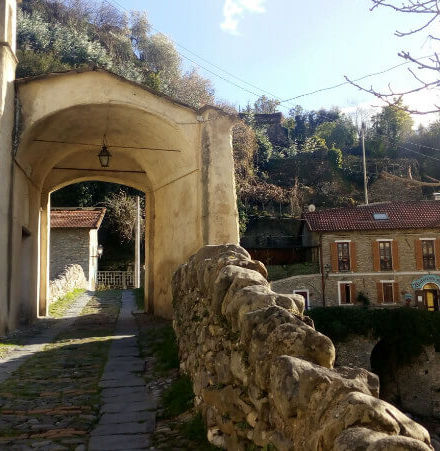
WELCOME TO BADALUCCO
Nestled by the bight of the river and surrounded by luxuriant nature: this is the extraordinary setting in which Badalucco can be found. A village of ancient history, built in the typical concetric style of Ligurian villages of the hinterland, perched on a rock sloping down from from the top of the hill towards the river. Situated at the beginning of the Argentina valley at a height of 179 metres, the village is about ten kilometres away from the coast and presents itself as an ideal alternative for visitors who enjoy nature, peace, relaxation and good food, away from the madding coastal crowds of the summer months.
Tourists interested in spending a holiday or just a day in Badalucco can discover the historic centre, meander through the maze of cobbled streets, covered passageways and enjoy panoramic views; lovers of photography have the opportunity of framing enchanting hidden corners of medieval architecture or the beautiful surrounding nature. You can visit the “Open air museum” a permanent installation of ceramics by internationally renowned artists and sculptors. The Badalucco Art Gallery hosts temporary painting and sculpture exhibitions of local and international artists as well as ceramic workshops. Badalucco is the home of well known olive mills which produce top quality extra virgin olive oil from the Taggiasca cultivar. The mills sell directly to the public: you can buy olive oil and other local products such as pesto, salted olives and sundried tomatoes as well as take interesting guided tours of the mills.
During the summer months you can take a dip in the cooling waters of the Argentina river, spend the balmy evenings sipping aperitivo in a bar while people watching or enjoy a wonderful dinner in an agriturismo or in one of our excellent restaurants. During the summer months Badalucco offers a varied calendar of events ranging from literary reviews to music festivals, from open air cinema to theatre shows as well as lively village fests. In Badalucco you will also find: a 5-a-side football pitch, a petanque ground with a picnic and barbecue area, R.E.L. hiking trails and riverside walks.

LIFE IN BADALUCCO
Known as the “FEEL-GOOD VILLAGE” for its sustainable way of life, Badalucco is a place where you can really feel part of a community. When not working, people here live mostly outdoors, tending to their vegetable gardens, enjoying their free time and the good weather, breathing clean air, drinking natural spring water or a good glass of wine. Have you ever wondered, while stuck in traffic jams or crushed like sardines on public transport about how good it would be to downsize and move somewhere you could live on a more “human scale”? This is Badalucco: a place to relax and enjoy life away from the smog, pollution and noise of the city, a place where the sounds that accompany your days and nights are those of the river, of the birds and the frogs singing and of children running around in the streets and village squares just like times past. A place where every day is an opportunity of joy and conviviality, where traditions are preserved and the community becomes family.

THINGS TO SEE
In ancient times the village was surrounded by walls with five access gates, all still well preserved and known as:
the POGGETTO gate
the SANTA LUCIA gate, with a double arched stone bridge and small chapel dedicated to St. Lucia
the SAN ROCCO gate adjacent to a small chapel dedicated to the Saints Rocco and Sebastian
the BEO gate
the CASTELLO gate which included the ancient Madonna di Laghet church, of which only the triangular bell tower remains.
The original settlement probably arose as early as the 12th-13th century at the foot of the Ventimiglia Castle, on the rock that dominated the Argentina river and the road leading to the upper valley. Later, thanks to the protection offered by the fortifications, other buildings were erected in a southerly direction towards the plain below. Among these were the elegant Palazzo of the Count as well as the 14th century church of Santa Maria della Teglia, a building today no longer in existence. The gothic palace in Via Gioberti, known as the Ancient Confraria, dates back to the end of the 14th century. With the end of Count Oberto's dominion, the Municipality went under the rule of the Republic of Genoa and a long period of peace and prosperity ensued.
The 15th century was the time when a large part of the urban fabric of the village was established. The dry stone houses, often plastered due to the availability of sand provided by the stream, tended to be located along the main road axes: the longitudinal one that crosses the village (Via Antonio Boeri, Via Marco Bianchi and Via Fontana) and the transversal one that crosses the town towards the north and extends from the Saint Lucia’s bridge through Via Ponte all the way up to the top of the hill.
